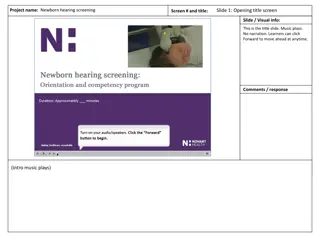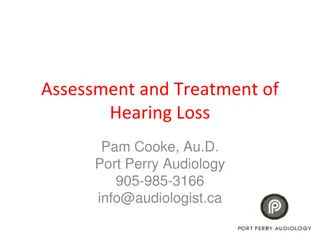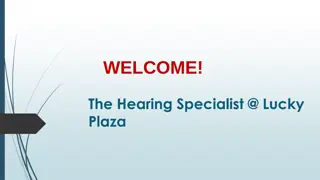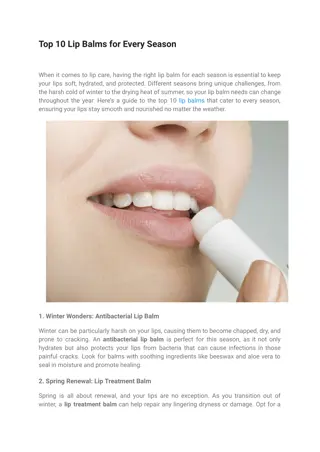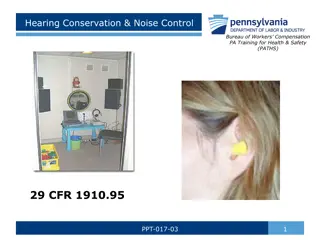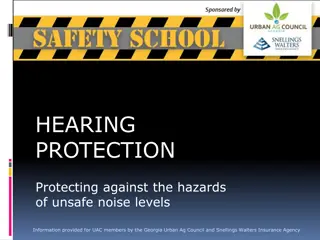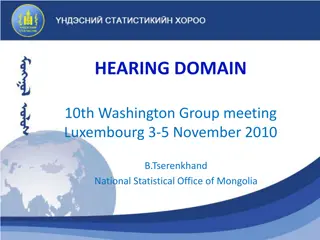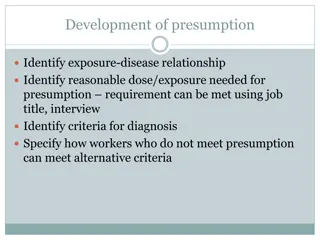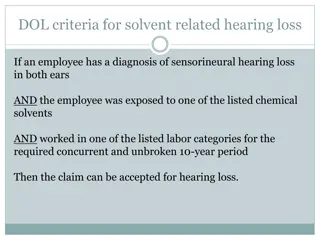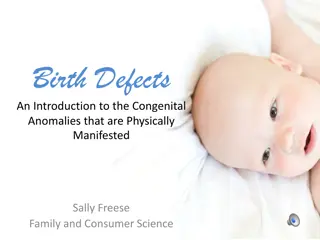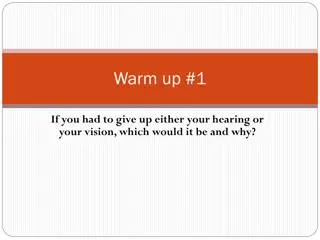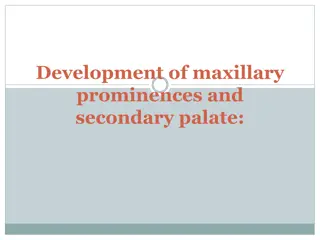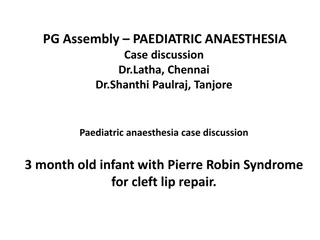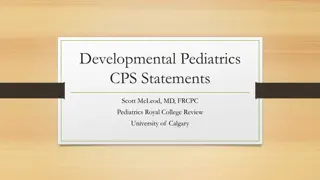HEARING LOSS IN UNILATERAL CLEFT LIP AND PALATE
Unilateral cleft lip and palate can lead to hearing loss due to structural defects during embryonic development, impacting craniofacial features and middle ear function. The etiology, incidence, and pathoanatomical features contribute to long-term complications affecting hearing ability in individuals with this condition.
Download Presentation

Please find below an Image/Link to download the presentation.
The content on the website is provided AS IS for your information and personal use only. It may not be sold, licensed, or shared on other websites without obtaining consent from the author.If you encounter any issues during the download, it is possible that the publisher has removed the file from their server.
You are allowed to download the files provided on this website for personal or commercial use, subject to the condition that they are used lawfully. All files are the property of their respective owners.
The content on the website is provided AS IS for your information and personal use only. It may not be sold, licensed, or shared on other websites without obtaining consent from the author.
E N D
Presentation Transcript
Hearing loss in Unilateral Cleft Lip and Palate Jadranka Handzic M.D., Ph.D., Professor of Otolaryngology, Audiology and Vestibulology Department for Otolaryngology and Audiology University Hospital Center Rebro Kispaticeva 12 Croatia HEARING LOSS IN UNILATERAL CLEFT LIP AND PALATE
Hearing loss in Unilateral Cleft Lip and Palate EMBRYOLOGY -Cleft lip and/or palate- one of the most frequent structural defect (1stbranchial arch) of the head and neck - fail of fusion of left and right mesoderm plate in the middle line primary palate origin at primary palate origin at 6thweeks of gestation -secondary palate secondary palate - 8-10thhard palate - 10-12thsoft palate
Hearing loss in Unilateral Cleft Lip and Palate ETIOLOGY-INCIDENCE - Etiology Etiology- multifactorial - -Incidence Incidence of isolated cleft lip and palate: 1 in 750 live births - left unilateral cleft lip and palate occurs twice as many males than females -
Hearing loss in Unilateral Cleft Lip and Palate PATHOANATOMICAL CRANIOFACIAL FEATURES-HIGH RISK OF LONG-TERM NEGATIVE MIDDLE EAR PRESSURE Cranial base Cranial base- - changes of the length and angulations of anterior cranial base, smaller sphenopalatine angle Eustachian tube Eustachian tube - hypoplastic and hypoelastic cartilaginous part, inadequate clearance and ventilation of the middle ear/development connection with growing of the middle face Maxilla Maxilla retrognathia, retarded middle face Pharyngeal Pharyngeal latero of the lateral wall, Passavant or circular ridge during deglutition latero- -lateral distance lateral distance- increase, cranio-caudal distance-decrease,pathologic movement Middle ear cavity Middle ear cavity - small mastoid and middle ear cavity - Cleft palate Cleft palate -short and high positioned-delay in descending Cleft palate muscles Cleft palate muscles-hypoplastic and malpositioned tensor and levator veli palatini, neuromuscular delay of maturity of the pharyngeal muscles
Hearing loss in Unilateral cleft Lip and Palate MORPHOLOGICAL CHANGES IN UNILATERAL CLEFT LIP AND PALATE MORPHOLOGICAL CHANGES IN UNILATERAL CLEFT LIP AND PALATE -retrognatic and retarded growth of maxilla -influence on the growth of the Eustachian tube region -lower position of auricula, -retarded growth of mandibula -colapse of the top of the nose and alar rotation, -relative hypertelorism
Hearing loss in Unilateral Cleft lip and Palate CLEFT LIP AND PALATE CHILDREN-UNIVERSALITY OF THE OTITIS MEDIA WITH EFFUSION -long term negative middle ear long term negative middle ear pressure ear mucosa and accumulation of the fluid in the middle ear; accumulation of the fluid in the middle ear; Otitis media with effusion Otitis media with effusion (OME)- the most common disease in childhood in childhood - - the most frequent cause of communication disorders most frequent cause of communication disorders pressure leads to edema of the middle most common disease OME OME- -usually finding in the left lip and palate children until 3yr. usually finding in the left lip and palate children until 3yr.
Hearing loss in Unilateral Cleft Lip and Palate OTITIS MEDIA WITH EFFUSION OTITIS MEDIA WITH EFFUSION Otoscopic finding Accumulation of the middle ear fluid
Hearing loss in Unilateral Cleft Lip and Palate CONDUCTIVE HEARING LOSS-EFFECT ON CENTRAL AUDITORY PROCESSING SPEECH DISCRIMINATION -distortion of the sound reaching cochlea distortion of the sound reaching cochlea-interaural delay in sound reaching the brain -disturbance of binaural central auditory processing disturbance of binaural central auditory processing ,disturbed inhibitory process on neural synapses -disturbance in neural encoding and tonotopic organization of primary auditory cortex, making short and long-term auditory working memory -negative influence negative influence on development of speech and language of speech and language acquisition, phonemic awareness-speech discrimination, cognition, fine motoric function, long term acoustic memory, balance, sound segregation in background noise- Otitis media with effusion leads to central auditory processing deficit even Otitis media with effusion leads to central auditory processing deficit even after the restoration of peripheral function and normalization of the hearing after the restoration of peripheral function and normalization of the hearing threshold threshold auditory working memory
Hearing loss in Unilateral cleft lip and palate UNILATERAL CLEFT LIP AND PALATE (UCLP) VS. BILATERAL CLEFT LIP AND PALATE (BCLP) COMPARATIVE STUDY OF HEARING LOSS 1) UCLP -higher incidence of hearing loss higher incidence of hearing loss ears 2) UCLP - lower lower incidence of ears with normal hearing threshold 2) UCLP - higher incidence higher incidence of ears with moderate 3) 3) UCLP - moderate hearing loss moderate hearing loss- - slower BCLP 4)ears with severe hearing loss severe hearing loss do not improve ears (89%) at age 1-3yr.than BCLP (62%) normal hearing threshold than BCLP moderate and severe severe hearing loss than BCLP slower improvement of hearing threshold than not improve hearing threshold with aging
Hearing loss in Unilateral cleft Lip and Palate TYMPANOMETRIC FINDINGS IN UCLP VS. BCLP EARS- COMPARATIVE STUDY UCLP- B type frequency higher at age 1-3yr than in BCLP and ICP - decreased faster than in the BCLP and ICP - UCLP decrease of B type from age 7-9yr,BCLP 4-6yr, ICP from 15yr. 100% 100% UCLP BCLP UCLP BCLP 90% 90% 80% 80% 70% 70% 60% 60% A type 50% 50% A type 40% 40% C type C type 30% 30% B type B type 20% 20% 10% 10% . 0% 0% 1-3 years 4-6 years 7-9 years 10-12 years 13-15 years 16-18 years 19-21 years 22+ years Age groups Ear/n= 244 Age groups Ear/n= 114
Hearing loss in Unilateral Cleft Lip and Palate MATOID BONE PNEUMATIZATION IN UNILATERAL CLEFT LIP AND PALATE OF LEFT VS. RIGHT SIDE UCLP-right and UCLP-left - mastoid bone pneumatization of left ears than mastoid bone pneumatization of right ears of left ears - - smaller
Hearing loss in Unilateral Cleft Lip and Palate AIM OF THE STUDY AND HYPOTHESIS Different pathoanatomical and developmental Different pathoanatomical and developmental characteristics of characteristics of anatomical structures of anatomical structures of cleft vs. non cleft side non cleft side have different mode of have different mode of pathopysiological development of middle ear disease pathopysiological development of middle ear disease cleft vs.
Hearing loss in Unilateral Cleft Lip and Palate METHOD Study included 101 children: median age 6 Study included 101 children: median age 6.0 - - 68 males 68 males - -33 females 33 females - - Palatoplasty and cheiloplasty performed previously according to Palatoplasty and cheiloplasty performed previously according to standard protocol standard protocol Hearing loss (tonal audiometry and tympanometry) analyzed Hearing loss (tonal audiometry and tympanometry) analyzed according to age subgroups : according to age subgroups : 1 1- -3 years,4 3 years,4- -7years,8 7years,8- -12 years 12 years .0 yr., yr.,
Hearing loss in Unilateral Cleft Lip and Palate AUDIOLOGIC TESTS-TYMPANOMETRY-TONAL AUDIOMETRY Tympanometry Tympanometry- - types according to Jerger; A,C,B Tonal audiometry; Tonal audiometry; Tested audiometric frequencies ; 250Hz,500Hz,1000Hz,2000Hz,4000Hz Normal hearing threshold: 0-10dB -mid hearing loss; 11-20dB -moderate hearing loss;21-40dB -severe hearing loss >40dB Results described and compared -median (Md) hearing level for tested frequencies - average hearing level (AHL) across speech frequencies Jerger; A,C,B
Hearing loss in Unilateral cleft lip and palate Hearing level (dB) Age N Ear Kruskal-Wallis AHL 250 Hz 500 Hz 1 kHz 2 kHz 4 kHz (years) (76) side test (p value) Md Md Md Md Md Md UCLP (Min-Max) (Min-Max) (Min-Max) (Min-Max) (Min-Max) (Min-Max) p=0.043 p=0.683 p=0.398 p=0.866 p=0.906 p=0.612 p=0.057 1-3 yr. 30 RIGHT ears 35.0 (16-41) 30.0 (20-40) 40.0 (20-50) 32.5 (15-50) 30.0 (15-45) 30.0 (10-50) LEFT ears 33.0 (20-42) 27.5 (20-45) 30.0 (15-40) 32.5 (15-45) 32.5 (15-50) 32.5 (15-50) p=0.601 p=0.039 p=0.052 p=0.054 p=0.003 p=0.387 p=0.410 p=0.001 4-7yr. 57 RIGHT ears 21.0 (10-47) 20.0 (10-45) 20.0 (10-45) 20.0 (10-55) 25.0 (10-45) 25.0 (10-55) p=0.003 LEFT ears 25.0 (10-47) 25.0 (10-50) 25.0 (10-50) 25.0 (10-50) 30.0 (10-45) 30.0 (10-50) p=0.906 p=0.790 p=0.650 p=0.979 p=0.875 p=0.382 8-12yr. 17 RIGHT ears 20.0 (10-41) 20.0 (10-45) 25.0 (10-35) 20.0 (10-50) 20.0 (10-30) 20.0 (10-55) p=0.294 p=0.028 LEFT ears 18.0 (10-47) 20.0 (10-45) 20.0 (10-45) 20.0 (10-55) 15.0 (10-40) 20.0 (10-55) p=0.043 p=0.052 p=0.110 p=0.787 p=0.866 p=0.590 >12yr. 12 RIGHT ears 16.0 (10-42) 12.0 (10-35) 15.0 (10-50) 17.5 (10-40) 10.0 (10-40) 10.0 (10-45) p=0.269 LEFT ears 18.0 (10-44) 17.5 (10-40) 15.0 (10-40) 17.5 (10-50) 17.0 (10-50) 17.5 (10-60) p=0.972
Hearing loss in Unilateral Cleft Lip and Palate RESULTS Age group Age group 1 1- -3yr. - non cleft side - highest severity of hearing loss ( (Md) 500Hz severity of hearing loss than lefts Age group 4 Age group 4- -7yr 7yr. ; AHL higher on cleft side - cleft side ears -higher severity of hearing loss for mid register (Md)(500Hz,1000Hz,4000Hz) -non cleft side-higher severity of hearing loss for low register (250Hz and 500Hz) 3yr.
Hearing loss in Unilateral Cleft Lip and Palate RESULTS Age group 8 Age group 8- -12 yr; hearing loss cleft vs.non cleft side showed no significant difference Cleft side ears- higher hearing loss on frequencies 500Hz,1000Hz then on others Age group >12 yr; Age group >12 yr; ear side dependence in severity of hearing loss showed frequencies of 2000Hz and 4000Hz-cleft side showed higher severity 12 yr;
UCLP- LEFT EAR (CLEFT SIDE) PROPORTION OF EARS WITH MILD,MODERATE AND SEVERE HEARING LOSS (AVERAGE) ACCORDING TO AGE SUBGROUPS Average hearing loss groups 100% 90% 80% 70% 60% Severe Moderate 50% Mild 40% Normal 30% 20% 10% 0% 1-3 years 4-7 years 8-12 years 13+ years Age groups
Hearing loss in Unilateral Cleft Lip and Palate RESULTS-CLEFT SIDE EARS - -age age group 40dB) group 1 1- -3yr 3yr. -80% of ears have moderate hearing loss (21- -i inciden ncidence decrease with aging decrease with aging ce of ears with moderate moderate hearing loss hearing loss significantly -no increase no increase of incidence with aging with aging incidence of ears with normal hearing normal hearing level level - -i intergroup comparison ntergroup comparison of hearing loss ears showed significant difference for moderate moderate category
UCLP- RIGHT EAR (NON-CLEFT SIDE) PROPORTION OF EARS WITH HEARING LOSS (AVERAGE HL)- MILD,MODERATE,SEVERE ACCORDING TO AGE SUBGROUPS 100% 90% AHL groups 80% 70% 60% Severe 50% Moderate 40% Mild Normal 30% 20% 10% 0% 1-3 years 4-7 years 8-12 years 13+ years Age groups
Hearing loss in Unilateral Cleft Lip and Palate RESULTS-NON CLEFT EARS Non cleft side ears Non cleft side ears ; Increased rate of ears with normal hearing threshold with aging Intergroup comparison showed significant difference for mid mid and moderate moderate category of hearing loss ears Intragroup comparison difference showed age group 4-7yr
Hearing loss in Unilateral Cleft Lip and Palate IMPROVEMENT OF HEARING THRESHOLD WITH AGING
Hearing loss in Unilateral cleft Lip and Palate CONCLUSION Cleft side ears : Cleft side ears : showed different pathophysiology of OME than none showed different pathophysiology of OME than none cleft side and difference in severity of hearing loss for cleft side and difference in severity of hearing loss for restrictive frequencies in dependence with ear side restrictive frequencies in dependence with ear side and age and age characteristics of hearing loss and its improvement characteristics of hearing loss and its improvement with aging determine speech and language with aging determine speech and language habilitation and prevention of central auditory habilitation and prevention of central auditory disorders disorders
Hearing loss in Unilateral cleft Lip and Palate WARM GREETINGS FROM ZAGREB,CROATIA



